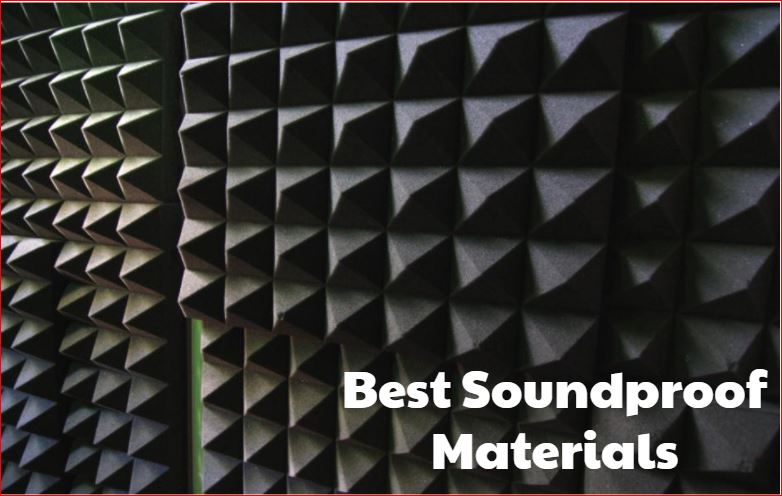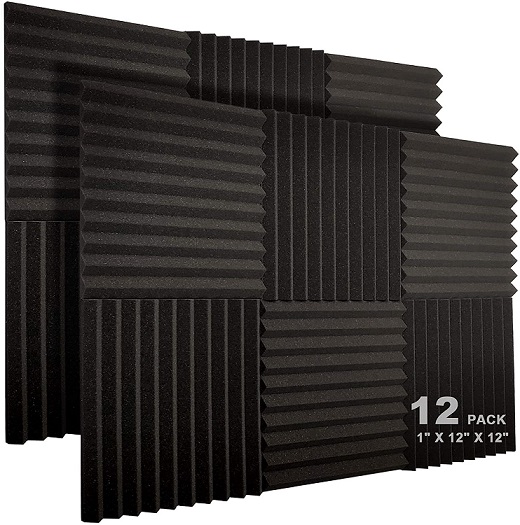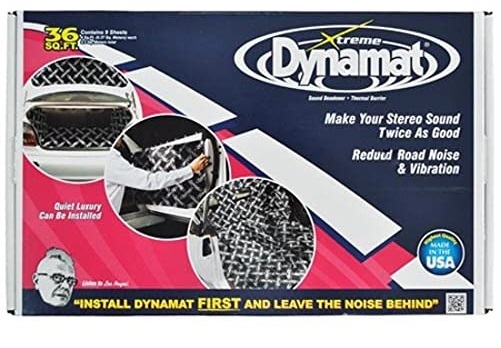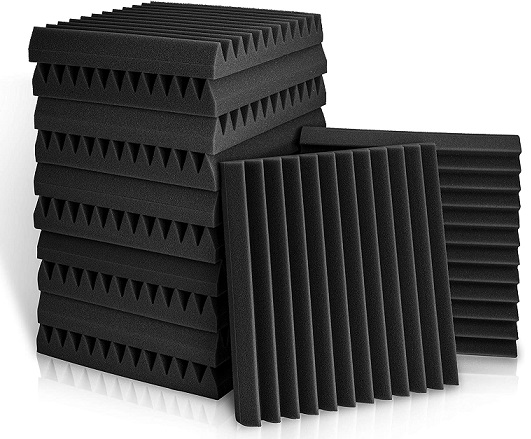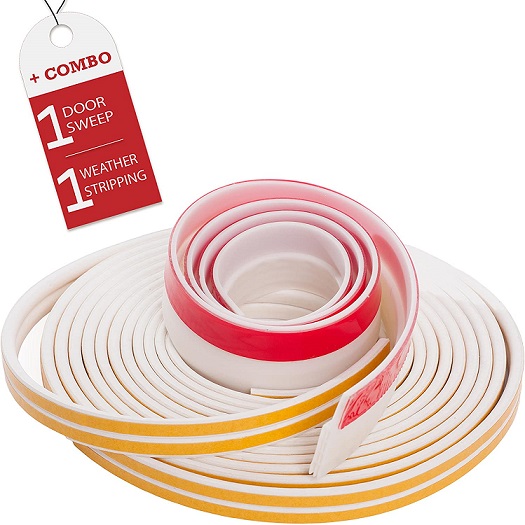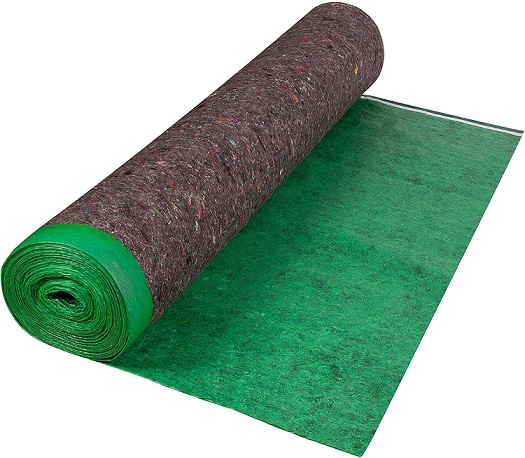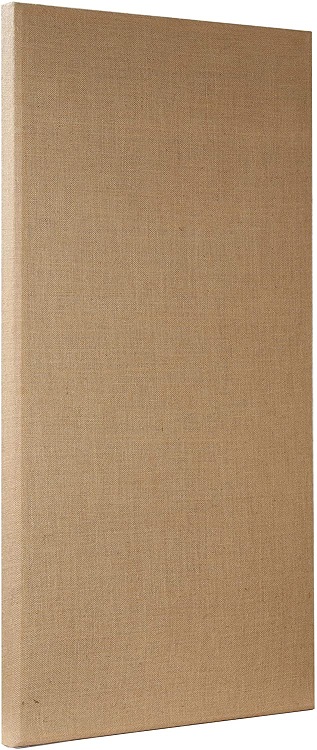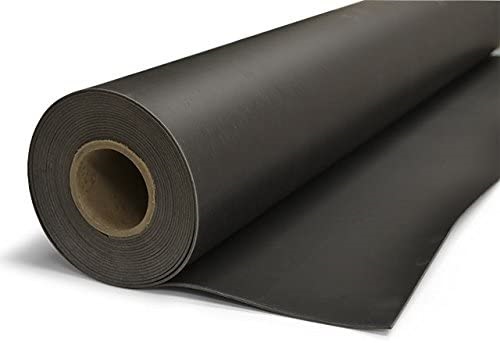Whether you want to improve the audio quality, block the outside noise or soundproof the flooring, you would need the right soundproof material.
The market is filled with different types of soundproof materials from acoustic foams to acoustic blankets and door sweeps. Each of these can work on a certain type of noise, making it difficult for you to narrow down your choices.
To help you purchase, we are enlisting the most popular and most reviewed soundproof materials that are popular in the market. And for first-time buyers, here are the most common soundproof materials and their uses:
Acoustic Foam/ Acoustic Panels- Best known as studio foams, acoustic foam panels are excellent at absorbing sound, echo and flutter. These are best for small studios, home and office use.
Acoustic Batts- Made of different materials like mineral wool, rock wool, fibreglass, acoustic batts fill in the gaps between the walls, which transmits noise and vibrations.
Acoustic Fabrics- Made of thick, dense materials, acoustic fabrics are often used as curtains or blankets made of polyester and polyester blends. They can absorb some of the noise and trap them within their folds.
Acoustic Coating: These are usually made of MLV or Mass Loaded vinyl. It’s often used for car soundproofing, appliances, machinery etc.
Floor Underlayment- Floor Underlayment uses materials like cork sheets, vinyl, rubber and foam to reduce noise and vibration caused by impact.
Door Seals and Sweeps: Seals the gaps between the door jamb and door sweep, which let in most of the unwanted noise.
Below is the list of the best soundproof materials:
Best Soundproof Materials 2022
Best Soundproof MaterialsTypeUseSizeBuy Now
JBER Soundproofing WedgesAcoustic Foam/ wedgeSpot treating sound. Studio, office, home1″ X 12″ X 12″Check On Amazon
Dynamat Sound DeadenerAcoustic coatingSoundproof cars18″ x 32″ x 0.067″Check On Amazon
Acoustic Panels Studio Wedge TilesAcoustic Foam PanelsStudio, home, office, commercial use2″ X 12″ X 12″Check On Amazon
Kanzzy Soundproof Weather Stripping Door KitSoundproof Weather Stripping Door KitSoundproof door, Wind, Dust, Draft & Insect Proof – Insulation43.3” Door SweepCheck On Amazon
Roberts Soundproof MaterialFloor UnderlaymentsFloor Soundproofing360 sq 60 in. x 72 ft. x 3 mmCheck On Amazon
Sure-Max 2 Moving & Packing BlanketsBlanketSoundproof blanket, packing blanket80″ x 72″Check On Amazon
ATS Acoustics PanelAcoustic Foam PanelsStudio, home, office, commercial use24x48x2 InchesCheck On Amazon
TMS Sound Proofing Padding for WallAcoustic Coating for WallSoundproof coating for wall. cars, ceiling, machinery4 x 25 FeetCheck On Amazon
Auralex Acoustics Studiofoam WedgiesAcoustic FoamStudio, home, office, commercial use2″ x 12″ x 12″Check On Amazon
Pro Studio Acoustic WedgeAcoustic FoamStudio, home, office, commercial use12″x12″x2″Check On Amazon
Best Soundproof Materials Reviews
1. JBER Soundproofing Wedges
Acoustic foam panels are a great choice for spot treating a small room or studio. JBER is probably the best soundproof solution for residential use because they are simple, efficient, and super easy to use. They are also reasonably priced means you can consider them if you need to spot treat a larger space.
Each tile measures exactly 1 square foot and is made of 1-inch thick acoustic foam. These are best known as studio foams because they instantly improve the audio quality for voice and video recording. It’s an effective noise deadener that flutters echoes and reduces background noise. Hence, they are also a good choice for keeping things quiet at crowded places like gyms, schools, and offices.
They have this distinctive pyramidal shape that traps sound reflections, reverberations and absorbs unwanted noise. The foam material is dense, firm and the sound absorption is consistent. They are available in three different colors. You can easily cut them into size if you wish. It will not affect its performance. The only downside is that they are a little on the pricier side.
Best Features:
Polyurethane acoustic panels
Noise deadener
Controls echo sound, reverb, and unwanted noise
Measures 12x 12 inches each
1 inch in thickness
Can be cut intodesirede size
Pros:
Easy to use
Affordable
Effective noise reduction
Cons:
Acoustic wedges don’t make a room soundproof. They are only good at reducing sound reflections, flutter and echo.
When it’s about car soundproofing, we suggest you buy nothing other than Dynamat. It’s surely one of the most popular brands for selling sound deadening mats for automobiles. Dynamat Xtreme comes in a bulk pack with a total of 9 sheets which you can use in various parts of the car door, floor, trunk etc.
It features an aluminum front and butyl-back which greatly reduces noise and vibrations inside a car. Since. It’s aluminium it also reflects heat keeping your car cool. And the butyl material at the back keeps it odorless. It’s pretty easy to put as well. It needs to be installed directly on the metal portion of the car. It goes completely undetectable as the car rim is put back in place.
Each of the sheets measures 18x 32-inch in size, and there is a total of 9 sheets that you will receive. Dynamat also has launched deadening kits for car deck, cabin, speaker boxes you can buy separately. You will also find Dynamt’s original version sound deadened, which is much cheaper than Dynamat. But comparing the two Dynamat Xtreme is lighter means it’s easier to install and is 4 times more effective at sound deadening as claimed by the brand.
Best Features:
Bulk package with a total of 9 sheets
Each of the sheets measures 18×32-inch and is 1.12 mm thick
Can be used on the car floor, doors, deck, trunk, boot.
The sheets are black anodised finished
It has an aluminium front and butyl rubber back
Odorless and reflects heat
Pros:
Great at sound, vibration reduction
Eay to install
Lightweight
Most trusted brand
Cons:
High priced
3. Acoustic Panels Studio Wedge Tiles
Next, we have another acoustic panel that does an excellent job at fluttering echoes and reducing background noise. These wedges have a surface area of 12×12 inches are and about 2 inches thick. These are ideal for spot treatments on walls of small studios.
These are made of polyurethane and the material is twice as thicker as the other acoustic foam that we reviewed, hence little more expensive. It’s ideal for spot-treating small studios, practice rooms, and home entertainment centers. It controls echoes, reverberation, and other by-products of sounds that can spoil the audio experience.
They have used high-density polyurethane which increases the sound clarity at a spot thereby you can enjoy the audio experience. They are available in packs of 12 and 24 and in 7 different colors. You can easily cut them into size if you wish. It will not affect its performance. The only downside is that they are a little on the pricier side.
Best Features:
Polyurethane acoustic panels
Noise deadener
Controls echo sound, reverb, and unwanted noise
Each wedge measures 12x 12 inches
2 inches in thickness
Can be cut into desired size
Pros:
Good at spot treatment
Controls echoes, reverberation, and other by-products of sounds
Easy soundproof solution
Cons:
Expensive
4. Kanzzy Soundproof Weather Stripping Door Kit
Most of the unwanted noise sneaks in through the door jam and the door sweep. Soundproof rubber gaskets or foam gaskets like this one can help seal the gaps in between while preventing the outside noise from entering your house.
Unlike most of the compressive gaskets, which are 39-inch sweep and can only cover the sides, the gasket from Kanzzy will seal it 360 degrees, leaving no gaps in between. It’s incredibly easy to use and will fit all 4 types of house doors. It’s made of silicone, and it’s self-adhesive.
All you need to do is remove the peel and stick it onto the gaps. It’s strong to firmy stick to the place, but it can be removed if needed without causing any damage to the door. The compressive gasket is enough to stick. It’s the cheapest soundproof solution if you are looking for that. These are also called weather stripping door tapes as it also helps in insulation. It seals the heat inside in winters and the air conditioner in summer.
Best Features:
The 43-inch strip covers all 4 sides
Blocks noise
Air-tight weatherstripping kit
Made of silicone
Peel and stick
Provides room insulation
Pros:
Simplest soundproof solution
Best for sealing door gaps that let in unwanted noise
Affordable
Provides insulation too
Cons:
The door sweep is for gaps that are bigger than 1 inch
5. Roberts Soundproof Material
To reduce sound transmission on hardwood and laminate floors the best thing you can do is use floor underlayments. The Roberts Super Felt floor underlayment is one of the best choices for a floor that makes too much noise.
It is made from recycled fibers that are compressed into a solid mat using high-temperature to make a material that can absorb noise. It’s 3 mm thick that reduces sound transmission from upper floors to lower floors, and also helps in providing insulation.
It’s a 36 feet square roll with adhesive strips on one side. It’s super easy to install. Simply peel the sticker and lay it on the wooden or laminate floor, and you’re done. Lastly, the floor underlayment can protect your hard floor from moisture and vapour. So you don’t have to worry about damaging your floor.
All in all, the Robert Super Felt is a great solution for noise-proofing a floor, increasing comfort and longevity.
Best Features:
Absorbs noise and reduce sound transmission
360 sq feet floor underlayment
3 mm in thickness
STC rating 66
IIC rating 67
Provides cushion comfort over hardwood floors
Protects laminate floor from moisture and humidity
Pros:
Easy stick-on floor underlayment
Excellent choice for soundproofing wooden and laminate floors
Affordable
Cons:
The fibres can cause an issue for asthmatic patients. Avoid keeping in close contact.
6. Sure-Max 2 Moving & Packing Blankets
If you are on a tight budget but want to get rid of the outside buzz, moving blankets are a pretty good choice. Even though they’re called moving blankets, these thick materials are widely used for their sound absorbing abilities.
This thick plush blanket is made of cotton batting and polyester, one of the best fabrics that’s used for reducing noise. These blankets weigh more than 5 pounds each. You can use them to cover a studio room, hang them over the windows, doors, and they will work just fine.
The zig-zag pattern double-lock stitch with polyester ensures its longevity. Though there are no grommets for hanging them like a curtain, you can hang them as you want because they are made for tough use. Overall, these blankets are a pretty decent choice if you want a pocket-friendly soundproof set-up.
Best Features:
Sound absorbing blankets
Each blanket measures 80″ x 72″
Made of pure cotton and polyester binding
Double-sided construction
Also available in multi-packs
Pros:
Great material
Affordable
Decent sound blocking
Cons:
Not ideal for professional use
Don’t like how acoustic wedges look like in a room? Well, you can try acoustic panels. These wooden frame panels are the best choices for rooms and studios where an acoustic widget doesn’t look aesthetically pleasing. They are great at absorbing reverberation and echo and works best for mid to high range noise. At a glance, they look like a large picture frame rather than a sound deadening panel.
The ATS acoustic panels are constructed with mineral wool and a solid wooden frame. On top of which, there is a 100% natural jute covering to make it look even more appealing. It reduces reflection from hard surfaces inside a room. Each acoustic panel has an NRC ( Noise reduction coefficient) rating between 0 t0 1. It’s one of the best sound-absorbing materials for budget studio set-ups.
Each of these panels measures 24x48x2 inches and 2 inches are sold as single pieces. It even comes with wall mounting hardware and an installation manual. They can be used as free-standing, wall-mountable or suspended from the ceiling for multidimensional noise control.
Best Features:
Controls reverb and echo
NRC rating 0 to 1
Come in single pieces
Diameters 24x48x2
Made of mineral wool covered in jute
Made in USA
Pros:
Great for studios, living room and auditoriums
Budget-friendly
Have an aesthetic appeal
Cons:
No size and color options
8. TMS Sound Proofing Padding for Wall
Those looking for professional-grade soundproofing can try out these soundproof pads from TMS. These are solid mass loaded vinyl sheets with an STC rating of 27. They are ⅛ inch thick and weigh almost 1 pound per square foot, which builds a highly potent noise barrier.
It’s a professional-grade wall padding and a noise dampener that works for a wide variety of noises. Whether it’s for residential applications, studio projects, or a machinery enclosure, the TMS soundproof wall padding comes with the smartest soundproof solutions.
It’s affordable, comparatively easy to use and comes with a wide range of applications. As a matter of fact, the TMS soundproofing material does not contain any harmful chemicals. All in all, it’s a great deal for the price you pay. And the best for studios, apartments, audio rooms.
Best Features:
⅛ inch thick vinyl sheets. Weighs 1 pound per square foot.
Perfect soundproofing solution for residential use as well as professional use
Comes in three different sizes- 16 sq ft, 40 sq ft and 100 sq ft.
It’s made in the USA.
Pros:
Thick vinyl sheets provides effective noise deadening
Affordable
Easy to install
Cons:
Cannot stop low bass
Odor issues
9. Auralex Acoustics Studiofoam Wedgies
When it comes to reducing acoustic reflections, there’s nothing like acoustic studio foam or wedgies. So, here’s another option for people looking for a budget studio or setup.
The Auralex Studiofoam Wedgies comes with an NRC rating of .80 which can significantly cut down on the acoustic reflections, reverberations, flutter and echo. This is why it’s excellent for recording audio, studio setups and even small home theatres.
Auralex has acoustic foams of different shapes and sizes, but these 2 inches thick foam wedges are the best sellers. It typically measures 12”x12”x2 inches and is available in two multipack sets. Also, they are classThese are charcoal gray in color, there’s another one in burgundy.
Best Features:
Polyurethane acoustic panels
NRC rating 0.80
Enhance audio quality
Best for small studios, home theatres, audio recording
Controls acoustic reflections, reverb, flutter
Each wedge measures 12x 12 inches
2 inches in thickness
Pros:
Affordable
Easy to use
Odor less
Available n multi packs
Cons:
You may still need bass traps
Perhaps acoustic foams are the easiest solution to low-budget studio setups and hence here’s another bunch of acoustic foams from Pro Studio Acoustics. Well, it’s pricier compared to the other we reviewed in the article, but you can expect better quality and looks.
Firstly, unlike most acoustic foams, these come in an uncompressed condition. The foam is not warped or damaged due to the packaging. It’s a pack of 12 foams, including 6 blue tiles and 6 black tiles. Each foam tile is 1 square foot and is exactly 2 inches thick. They have an NRC rating of 0.65, which is great. On top of that, it’s class a fire retardant by ASTM E8.
There’s no adhesive on the tiles. So, installing it might be a little cumbersome. But once done, they can greatly reduce standing waves, flutter and echoes. These are excellent choices for home studios, gaming centres, home entertainment theatres, control rooms etc.
Best Features:
Polyurethane acoustic panels
NRC rating 0.65
Controls echo, flutter, reverb, and other by-products of sounds
Each wedge measures 12x 12 inches
2 inches in thickness
Can be cut into desired size
Pros:
Good at spot treatment
Ideal for home studios, gaming centres, home entertainment theatres, control rooms etc.
Cons:
Expensive
Best Soundproof Material Buying Guide
The first thing you need to determine when buying soundproof materials is what type of noise you’re dealing with. Airborne noise transmits through the air. The airborne sound echoes reverbs or flutters within a room. Impact noise is created when one object impacts on another. It can be a bouncing ball or people walking, or construction work.
Flanking noise is the additional noise interruption that sneaks in through the ductwork. Flanking noise can be more difficult to isolate.
Below are the lists of soundproof materials for different scenarios:
Types of Soundproofing Materials
These are the most used materials for soundproofing. Each of thhasave a different purpose and are used in different cases. Read below to know more about them:
1. Acoustic Foam
Acoustic foams are commonly known as studio foam. They are wedge or pyramidal in shape that are made of polyurethane. These are great at absorbing sound and preventing noise generated on hard surfaces. They can be attached to the ceiling hanging from the walls. They convert sound energies into heat. These are used for improved audio quality, especially within small home studios.
2. Sound Insulation Batts
Sound insulation materials are often called acoustic batts that can be made of different materials such as mineral wool, stone wool, cellulose, cotton or fiberglass. They are designed to be placed in between the studs in the walls. They work by taking up the space between the walls that would otherwise transmit noise. Not only dampen the noise but also block the movement of heat and cold.
3. Acoustic Fabrics
Acoustic fabrics are thicker, denser materials that trap sound vibrations, echo, and reverb. Some great acoustic fabrics are heavy plush curtains made of polyester, studio blankets, blackouts and acoustic wall panels. They stop the sound movement within their folds. They also convert sound energy into heat.
5. Acoustic Panels
These are usually acoustic foams that are used for decorative purposes in studios, gaming parlours and entertainment hubs. They come in appealing colors, sizes and shapes. They reduce the sound movements inside a room. They are good at improving audio quality. But not that efficient at trapping bass.
6. Acoustic Coating
Acoustic coatings are certain materials used for reducing vibrational movements. It dampens noise movements through the material. The most common material used for acoustic coating is Mass Loaded Vinyl or MLV. It’s a dense, flexible material often used for car soundproofing, appliances, machinery etc. These are viscoelastic in nature. Other materials used for acoustic coatings are MDF, putty pads, green glue, high impact foams etc.
7. Floor Underlayment
Hardwood, marble or ceramic tiles can create unwanted noise because of the impact it encounters. The flooring will require acoustic decoupling in order to prevent noise transmission. There are a variety of materials used on hard floors to deaden sound waves. The denser the material, the better will be the noise prevention. Cork rolls, acoustic foam layers, and polymers are commonly used for floor underlayment. They are usually ⅛” to ¼” thick.
8. Door Seals and Sweeps
Most of the unwanted noise travels through the gaps between the door jam and the door sweep. Sealing this area is a quick-fix solution to reduce sound movement. These days the self-adhesive weatherstripping kits are very popular. They can be directly used on the door jam to seal it completely so that it compresses every time the door closes.
The noise that bounces through the door sweep can be blocked by using a self-adhesive door-sweep or an automatic sweep.
9. Acoustic Decoupling
Acoustic decoupling typically means spraying a layer of soundproof material to prevent sound vibrations from travelling. It is usually used in construction to fill in gaps and separate walls to prevent motions and sound waves from travelling from one layer to another. Some acoustic decoupling methods are acoustic drywall, sound clips and double-wall construction.
10. Architectural Soundproofing
Soundproof walls, floors, windows, anything that’s used in the structure of a soundproof building is architectural soundproofing.
Important Factors to Consider
1. The noise level
The level or intensity of the noise someone wants to lock in or out will help decide the right kind of soundproofing materials. For minimal soundproofing, say you want to improve the audio quality, reduce the echo and flutter; soft foams will be good enough. It will absorb most of the unwanted noise. Acoustic foams, soundproof wall pads, acoustic blankets, soundproof curtains are great for this purpose. On the other hand, to block noise emerging from heavy-duty machines, you will need more advanced and professional-grade sound insulation.
2. Propagation of Sound
There can be two types of noise interference, airborne and structure born. For the right type of soundproofing, you need to know the character of the noise and how it travels from the source towards the receiver. Some soundproofing materials effectively prevent airborne noise transmission, while some methods work better for structure-borne noise.
3. The Material Used
The soundproof material matters a lot. You have to consider a few things mentioned below:
Sound waves are vibrations, so the materials which decrease the vibrations will also decrease the noise transmission.
Thickness- the thicker the materials the better will be its sound absorption abilities.
Density- Density is defined by mass per unit volume. Density increases the sound absorption coefficient, which means the sound absorption will increase as the density increases.
Porosity- the porosity in the soundproof material is important. Sound waves cannot pass through a porous material due to the cellular structure, which creates a wavy twisted path, and the straight sound waves cannot pass through it. Hence, it’s captured and is transformed into heat.
4. NRC Rating
NRC refers to Noise Reduction Coefficient, a numerical value that determines the sound-absorbing or reflecting capacity of the material. It ranges from 0 to 1.0. The greater the value, the better is the noise reduction.
5. STC and IIC Rating
STC or Sound Transmission class is a numerical value that rates wall partitions depending on how well they can prevent noise transmission. A higher STC rating indicates better noise insulation.
An STC of 40 is standard where you can still hear loud talking, but it’s reduced. STC 50 will mute loud voices. Increasing the STC value up to 60 is considered to be excellent. It can deaden loud noises coming from musical instruments.
IIC refers to Impact Isolation Class which determines a material’s ability to absorb impact.
Similar to STC, the higher the value, the better the performance.
6. Thermal Insulation
Some soundproof materials come with thermal insulation features. Not only do they dampen noise but they also work as a room insulator. If you have soundproof materials installed in your rooms, you can expect some level of thermal insulation inside the room.
7. Additional Soundproofing
Even if you have taken the primary measurements required for general soundproofing, some loopholes will still let in unwanted noise. For that additional soundproofing, you need to fill in the gaps left between the door and the floor. That’s a major gateway for unwanted noise. You can use soundproof tapes to seal the door jam and the door sweep. It will ensure that there is no space left for that unwanted noise to come in or go out.
8. Installation and Maintenance
You should not forget about the installation and maintenance when it comes to choosing the best soundproof material. For example, building a small home studio or acoustic theatre foams will do just fine if you only want to improve the audio quality. They are easy to install, and they last for a pretty good time. You thought of something that completely blocks the noise, like acoustic panels or acoustic fiberboard, but these may be slight overkill for your use.
Frequently Asked Questions
How to soundproof a bedroom?
For soundproofing a bedroom, start with choosing heavy thick soundproof curtains. You can also consider hanging soundproof blankets on your doors and windows. Then seal the door and the door sweep with weather stripping door tape. It’s important because most of the unwanted sound travels through this small passage) If that doesn’t work, consider installing window caulking. Acoustic foams would work, but that can ruin your bedroom aesthetics.
What can I put on walls to absorb noise?
The best and the easiest thing to install on the walls that will absorb most of the unwanted noise is acoustic foam or acoustic wedges. Acoustic blankets are also good options. You can hang them like curtains.
What’s the best soundproof material for windows?
The easiest way to soundproof a window is hanging soundproof curtains or blankets from the ceiling. It’s a cheap and easy solution that can block the noise from going in or out. You can also consider installing window caulk or use weather stripping tapes to seal the sides.
Conclusion
Well, there are too many options to choose from when it comes to soundproof materials. But the fact that each of them serves different purposes makes the job difficult for you. Choosing the right type of soundproof materials will depend on the type of noise you want to block, the space you have, and the installation procedure.
You may not even need a fully soundproof room. A soundproof curtain, soundproof wedges may be just fine for your use. Choose wisely, as these materials don’t come cheap. What will work for a home studio will not work for machinery or car soundproofing. And for that extra soundproofing, use door seals and sweeps.
Have you found the right material for soundproofing? If not, then let us help you.
Here are our top three recommendations for you:
For small studio setups, home theatres, office or commercial use, you can choose the JBER 12 Pack Acoustic Foam Panels. Each tile is around 1” thick and made of high-quality polyurethane. You can expect pretty good improvement in the audio quality. It will significantly reduce the echo, flutter and reverb that’s excellent considering its price.
If you are looking for a material for car soundproofing, choose nothing but Dynamat. It’s a pack of total of 9 sheets, each of which is made of aluminium front and butyl back. It will significantly reduce the noise and vibration while keeping your car odorless. It’s quite lightweight means it is easy to install. It may be a little on the pricier side, but it’s worth every penny.
If you want a soundproof floor go with the Roberts Underlayment Roll. It works great for laminate and engineered wood floors. It’s a 360 sq ft roll with STC and ICC ratings of 66 and 67, respectively.
The post 10 Best Soundproof Materials Reviews in 2022 appeared first on Electronics Hub.
Read more: electronicshub.org
